Energy Efficiency and Sustainable Systems in Victoria, Australia
VerifiedAdded on 2020/05/11
|13
|2968
|104
Report
AI Summary
This report provides a comprehensive analysis of sustainable energy systems and energy efficiency, with a specific focus on the state of Victoria, Australia. It examines the concept of energy efficiency, its importance, and the various methods to achieve it, including the use of renewable energy sources and technological advancements. The report delves into the energy usage patterns in Victorian households, highlighting the impact of appliances and offering strategies for reducing energy consumption. It further explores the energy landscape of Victoria, including the sources of energy production, the contribution of brown coal, and the state's overall carbon emissions. The role of organizations promoting energy efficiency in Australia, such as the Energy Efficiency Council and Environment Business Australia, is discussed, along with regulatory, social, financial, and marketing attempts to reduce energy consumption. The report also presents opportunities for decreasing energy consumption, such as wearing appropriate clothing, setting thermostats, and using energy-efficient appliances. A cost-benefit analysis for the use of energy-efficient light globes is also included, which evaluates the financial implications of switching to more efficient lighting options.
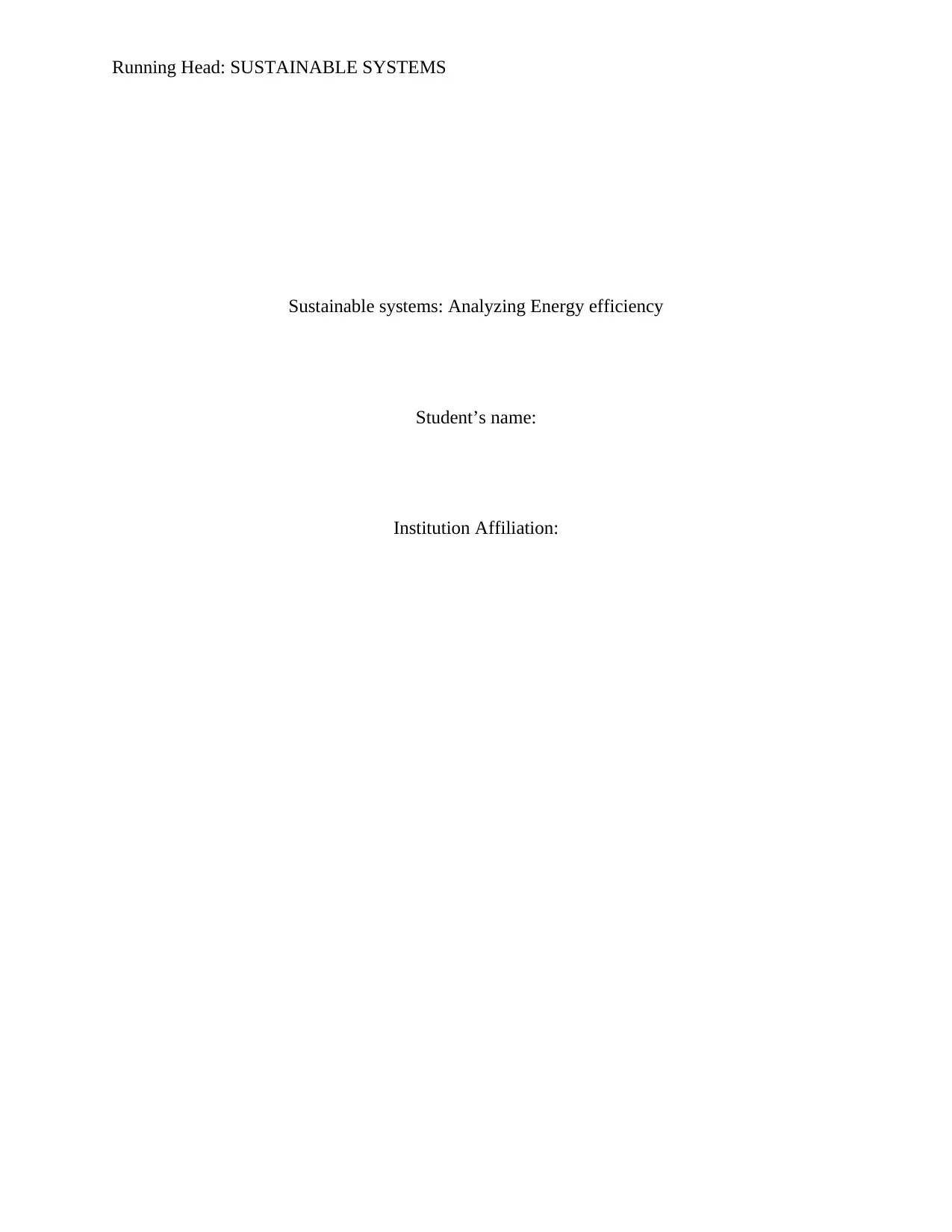
Running Head: SUSTAINABLE SYSTEMS
Sustainable systems: Analyzing Energy efficiency
Student’s name:
Institution Affiliation:
Sustainable systems: Analyzing Energy efficiency
Student’s name:
Institution Affiliation:
Paraphrase This Document
Need a fresh take? Get an instant paraphrase of this document with our AI Paraphraser
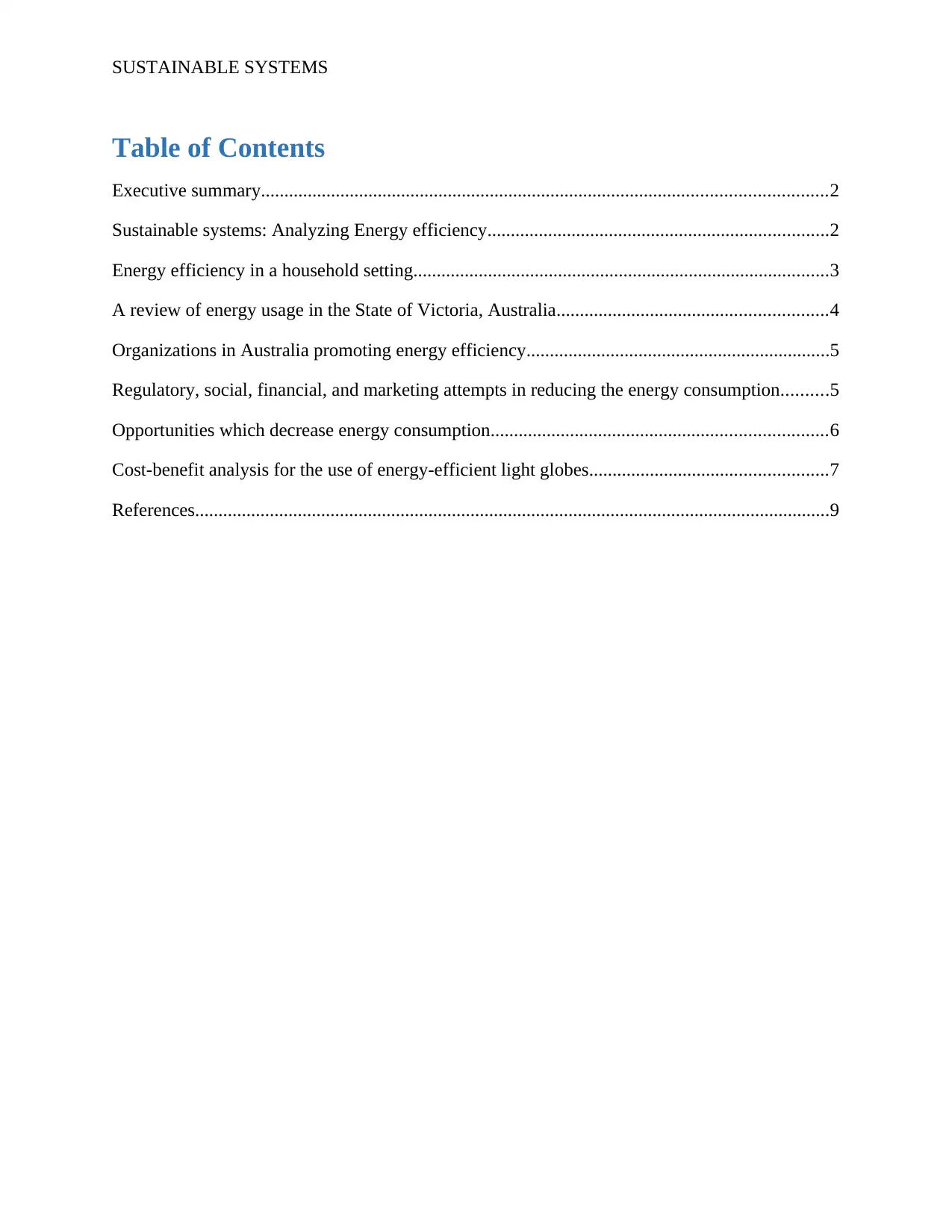
SUSTAINABLE SYSTEMS
Table of Contents
Executive summary.........................................................................................................................2
Sustainable systems: Analyzing Energy efficiency.........................................................................2
Energy efficiency in a household setting.........................................................................................3
A review of energy usage in the State of Victoria, Australia..........................................................4
Organizations in Australia promoting energy efficiency.................................................................5
Regulatory, social, financial, and marketing attempts in reducing the energy consumption..........5
Opportunities which decrease energy consumption........................................................................6
Cost-benefit analysis for the use of energy-efficient light globes...................................................7
References........................................................................................................................................9
Table of Contents
Executive summary.........................................................................................................................2
Sustainable systems: Analyzing Energy efficiency.........................................................................2
Energy efficiency in a household setting.........................................................................................3
A review of energy usage in the State of Victoria, Australia..........................................................4
Organizations in Australia promoting energy efficiency.................................................................5
Regulatory, social, financial, and marketing attempts in reducing the energy consumption..........5
Opportunities which decrease energy consumption........................................................................6
Cost-benefit analysis for the use of energy-efficient light globes...................................................7
References........................................................................................................................................9
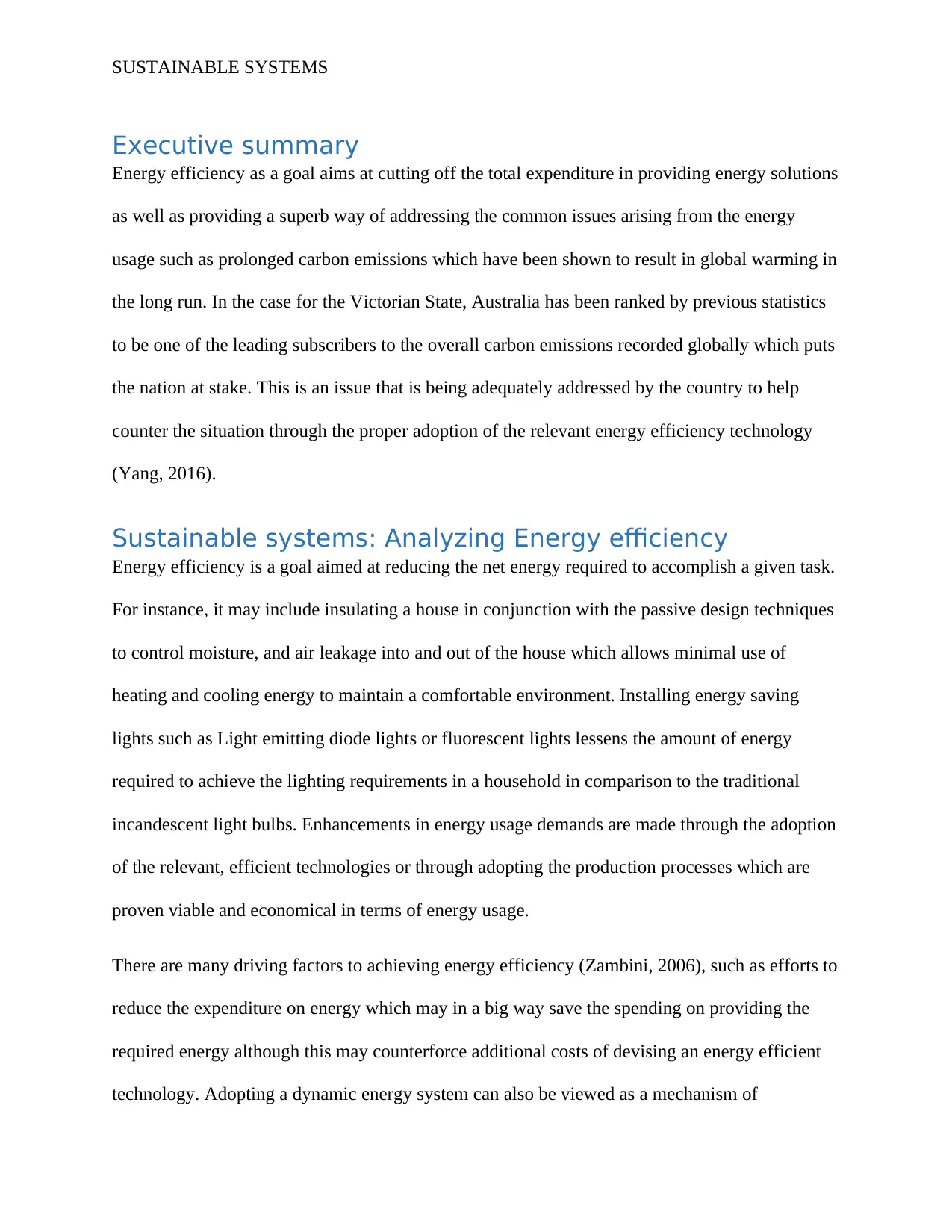
SUSTAINABLE SYSTEMS
Executive summary
Energy efficiency as a goal aims at cutting off the total expenditure in providing energy solutions
as well as providing a superb way of addressing the common issues arising from the energy
usage such as prolonged carbon emissions which have been shown to result in global warming in
the long run. In the case for the Victorian State, Australia has been ranked by previous statistics
to be one of the leading subscribers to the overall carbon emissions recorded globally which puts
the nation at stake. This is an issue that is being adequately addressed by the country to help
counter the situation through the proper adoption of the relevant energy efficiency technology
(Yang, 2016).
Sustainable systems: Analyzing Energy efficiency
Energy efficiency is a goal aimed at reducing the net energy required to accomplish a given task.
For instance, it may include insulating a house in conjunction with the passive design techniques
to control moisture, and air leakage into and out of the house which allows minimal use of
heating and cooling energy to maintain a comfortable environment. Installing energy saving
lights such as Light emitting diode lights or fluorescent lights lessens the amount of energy
required to achieve the lighting requirements in a household in comparison to the traditional
incandescent light bulbs. Enhancements in energy usage demands are made through the adoption
of the relevant, efficient technologies or through adopting the production processes which are
proven viable and economical in terms of energy usage.
There are many driving factors to achieving energy efficiency (Zambini, 2006), such as efforts to
reduce the expenditure on energy which may in a big way save the spending on providing the
required energy although this may counterforce additional costs of devising an energy efficient
technology. Adopting a dynamic energy system can also be viewed as a mechanism of
Executive summary
Energy efficiency as a goal aims at cutting off the total expenditure in providing energy solutions
as well as providing a superb way of addressing the common issues arising from the energy
usage such as prolonged carbon emissions which have been shown to result in global warming in
the long run. In the case for the Victorian State, Australia has been ranked by previous statistics
to be one of the leading subscribers to the overall carbon emissions recorded globally which puts
the nation at stake. This is an issue that is being adequately addressed by the country to help
counter the situation through the proper adoption of the relevant energy efficiency technology
(Yang, 2016).
Sustainable systems: Analyzing Energy efficiency
Energy efficiency is a goal aimed at reducing the net energy required to accomplish a given task.
For instance, it may include insulating a house in conjunction with the passive design techniques
to control moisture, and air leakage into and out of the house which allows minimal use of
heating and cooling energy to maintain a comfortable environment. Installing energy saving
lights such as Light emitting diode lights or fluorescent lights lessens the amount of energy
required to achieve the lighting requirements in a household in comparison to the traditional
incandescent light bulbs. Enhancements in energy usage demands are made through the adoption
of the relevant, efficient technologies or through adopting the production processes which are
proven viable and economical in terms of energy usage.
There are many driving factors to achieving energy efficiency (Zambini, 2006), such as efforts to
reduce the expenditure on energy which may in a big way save the spending on providing the
required energy although this may counterforce additional costs of devising an energy efficient
technology. Adopting a dynamic energy system can also be viewed as a mechanism of
⊘ This is a preview!⊘
Do you want full access?
Subscribe today to unlock all pages.

Trusted by 1+ million students worldwide
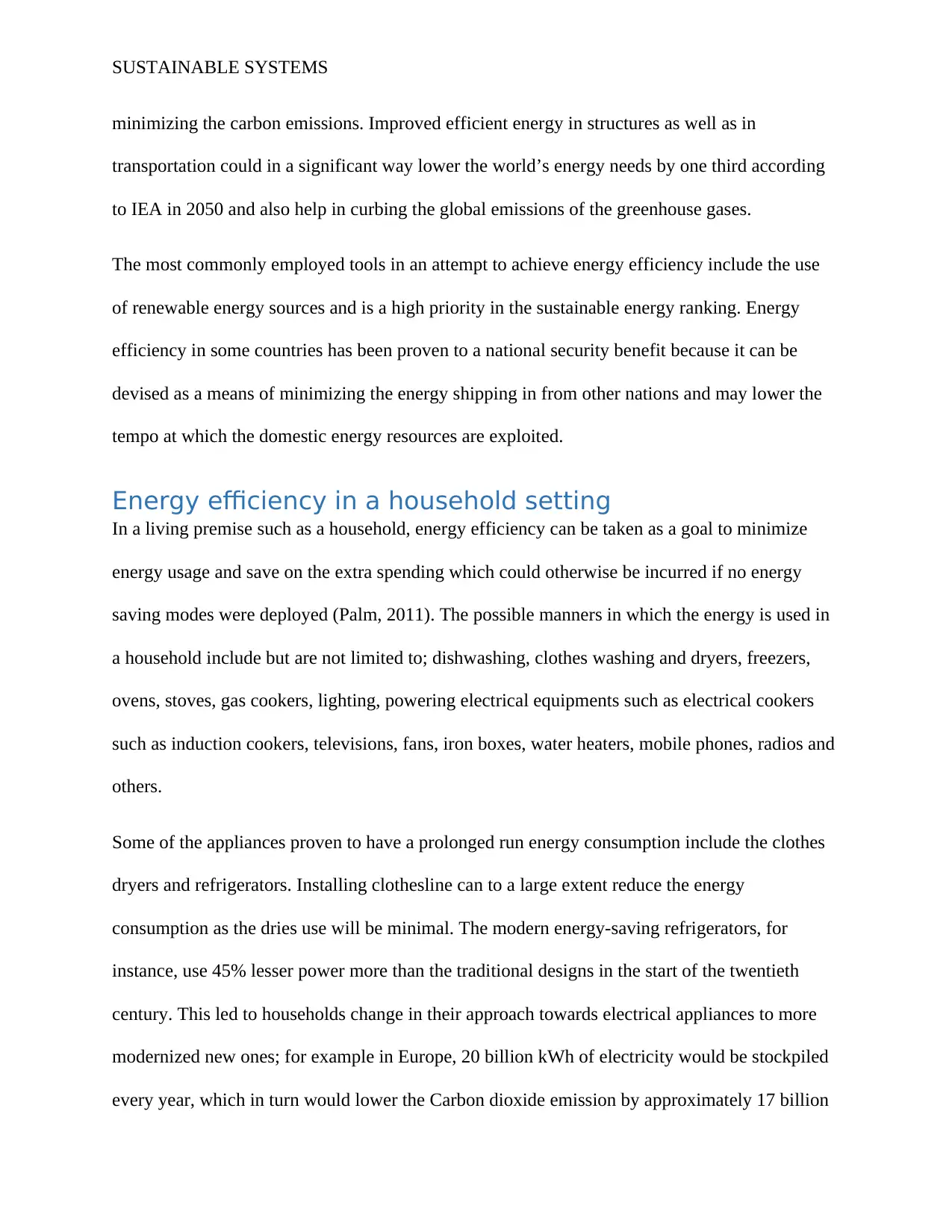
SUSTAINABLE SYSTEMS
minimizing the carbon emissions. Improved efficient energy in structures as well as in
transportation could in a significant way lower the world’s energy needs by one third according
to IEA in 2050 and also help in curbing the global emissions of the greenhouse gases.
The most commonly employed tools in an attempt to achieve energy efficiency include the use
of renewable energy sources and is a high priority in the sustainable energy ranking. Energy
efficiency in some countries has been proven to a national security benefit because it can be
devised as a means of minimizing the energy shipping in from other nations and may lower the
tempo at which the domestic energy resources are exploited.
Energy efficiency in a household setting
In a living premise such as a household, energy efficiency can be taken as a goal to minimize
energy usage and save on the extra spending which could otherwise be incurred if no energy
saving modes were deployed (Palm, 2011). The possible manners in which the energy is used in
a household include but are not limited to; dishwashing, clothes washing and dryers, freezers,
ovens, stoves, gas cookers, lighting, powering electrical equipments such as electrical cookers
such as induction cookers, televisions, fans, iron boxes, water heaters, mobile phones, radios and
others.
Some of the appliances proven to have a prolonged run energy consumption include the clothes
dryers and refrigerators. Installing clothesline can to a large extent reduce the energy
consumption as the dries use will be minimal. The modern energy-saving refrigerators, for
instance, use 45% lesser power more than the traditional designs in the start of the twentieth
century. This led to households change in their approach towards electrical appliances to more
modernized new ones; for example in Europe, 20 billion kWh of electricity would be stockpiled
every year, which in turn would lower the Carbon dioxide emission by approximately 17 billion
minimizing the carbon emissions. Improved efficient energy in structures as well as in
transportation could in a significant way lower the world’s energy needs by one third according
to IEA in 2050 and also help in curbing the global emissions of the greenhouse gases.
The most commonly employed tools in an attempt to achieve energy efficiency include the use
of renewable energy sources and is a high priority in the sustainable energy ranking. Energy
efficiency in some countries has been proven to a national security benefit because it can be
devised as a means of minimizing the energy shipping in from other nations and may lower the
tempo at which the domestic energy resources are exploited.
Energy efficiency in a household setting
In a living premise such as a household, energy efficiency can be taken as a goal to minimize
energy usage and save on the extra spending which could otherwise be incurred if no energy
saving modes were deployed (Palm, 2011). The possible manners in which the energy is used in
a household include but are not limited to; dishwashing, clothes washing and dryers, freezers,
ovens, stoves, gas cookers, lighting, powering electrical equipments such as electrical cookers
such as induction cookers, televisions, fans, iron boxes, water heaters, mobile phones, radios and
others.
Some of the appliances proven to have a prolonged run energy consumption include the clothes
dryers and refrigerators. Installing clothesline can to a large extent reduce the energy
consumption as the dries use will be minimal. The modern energy-saving refrigerators, for
instance, use 45% lesser power more than the traditional designs in the start of the twentieth
century. This led to households change in their approach towards electrical appliances to more
modernized new ones; for example in Europe, 20 billion kWh of electricity would be stockpiled
every year, which in turn would lower the Carbon dioxide emission by approximately 17 billion
Paraphrase This Document
Need a fresh take? Get an instant paraphrase of this document with our AI Paraphraser
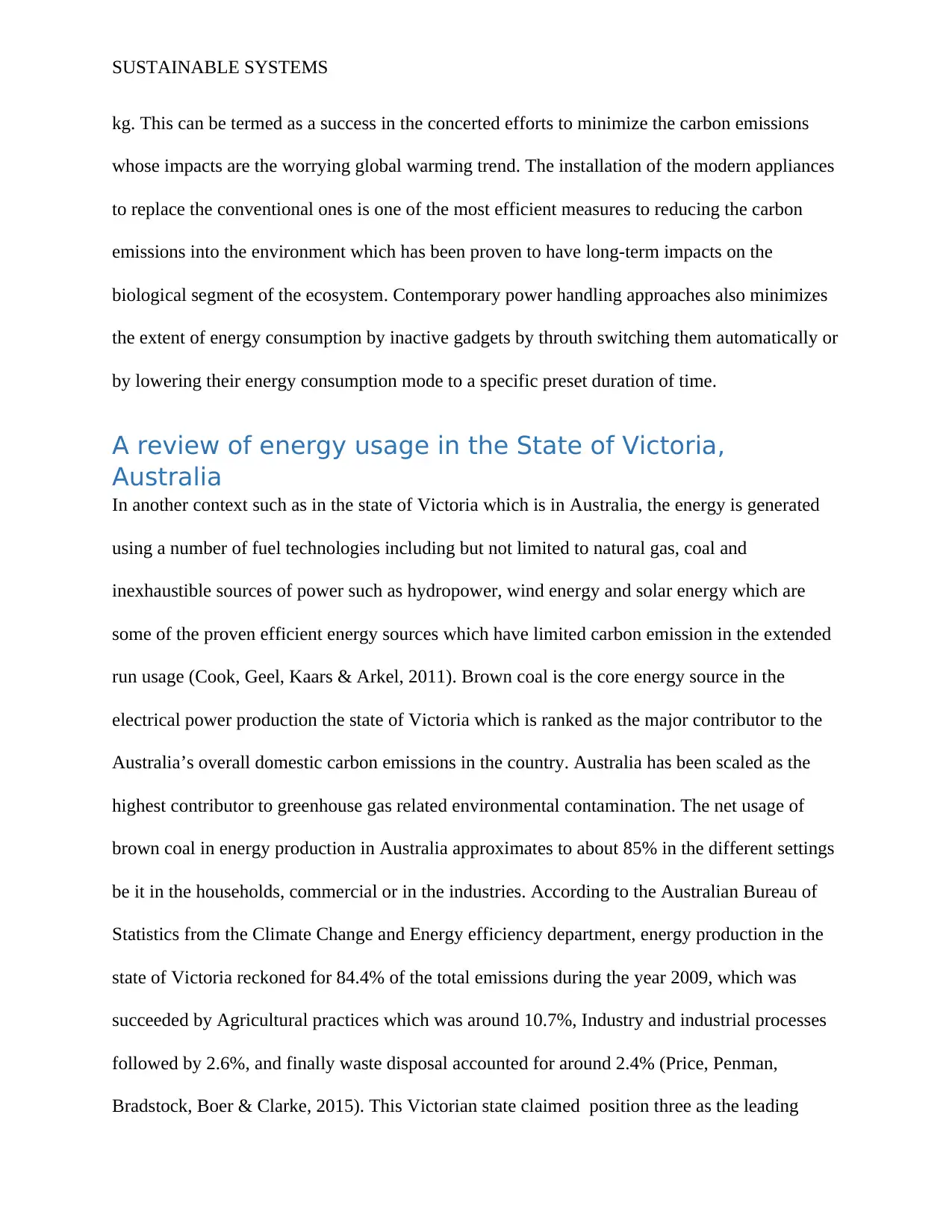
SUSTAINABLE SYSTEMS
kg. This can be termed as a success in the concerted efforts to minimize the carbon emissions
whose impacts are the worrying global warming trend. The installation of the modern appliances
to replace the conventional ones is one of the most efficient measures to reducing the carbon
emissions into the environment which has been proven to have long-term impacts on the
biological segment of the ecosystem. Contemporary power handling approaches also minimizes
the extent of energy consumption by inactive gadgets by throuth switching them automatically or
by lowering their energy consumption mode to a specific preset duration of time.
A review of energy usage in the State of Victoria,
Australia
In another context such as in the state of Victoria which is in Australia, the energy is generated
using a number of fuel technologies including but not limited to natural gas, coal and
inexhaustible sources of power such as hydropower, wind energy and solar energy which are
some of the proven efficient energy sources which have limited carbon emission in the extended
run usage (Cook, Geel, Kaars & Arkel, 2011). Brown coal is the core energy source in the
electrical power production the state of Victoria which is ranked as the major contributor to the
Australia’s overall domestic carbon emissions in the country. Australia has been scaled as the
highest contributor to greenhouse gas related environmental contamination. The net usage of
brown coal in energy production in Australia approximates to about 85% in the different settings
be it in the households, commercial or in the industries. According to the Australian Bureau of
Statistics from the Climate Change and Energy efficiency department, energy production in the
state of Victoria reckoned for 84.4% of the total emissions during the year 2009, which was
succeeded by Agricultural practices which was around 10.7%, Industry and industrial processes
followed by 2.6%, and finally waste disposal accounted for around 2.4% (Price, Penman,
Bradstock, Boer & Clarke, 2015). This Victorian state claimed position three as the leading
kg. This can be termed as a success in the concerted efforts to minimize the carbon emissions
whose impacts are the worrying global warming trend. The installation of the modern appliances
to replace the conventional ones is one of the most efficient measures to reducing the carbon
emissions into the environment which has been proven to have long-term impacts on the
biological segment of the ecosystem. Contemporary power handling approaches also minimizes
the extent of energy consumption by inactive gadgets by throuth switching them automatically or
by lowering their energy consumption mode to a specific preset duration of time.
A review of energy usage in the State of Victoria,
Australia
In another context such as in the state of Victoria which is in Australia, the energy is generated
using a number of fuel technologies including but not limited to natural gas, coal and
inexhaustible sources of power such as hydropower, wind energy and solar energy which are
some of the proven efficient energy sources which have limited carbon emission in the extended
run usage (Cook, Geel, Kaars & Arkel, 2011). Brown coal is the core energy source in the
electrical power production the state of Victoria which is ranked as the major contributor to the
Australia’s overall domestic carbon emissions in the country. Australia has been scaled as the
highest contributor to greenhouse gas related environmental contamination. The net usage of
brown coal in energy production in Australia approximates to about 85% in the different settings
be it in the households, commercial or in the industries. According to the Australian Bureau of
Statistics from the Climate Change and Energy efficiency department, energy production in the
state of Victoria reckoned for 84.4% of the total emissions during the year 2009, which was
succeeded by Agricultural practices which was around 10.7%, Industry and industrial processes
followed by 2.6%, and finally waste disposal accounted for around 2.4% (Price, Penman,
Bradstock, Boer & Clarke, 2015). This Victorian state claimed position three as the leading
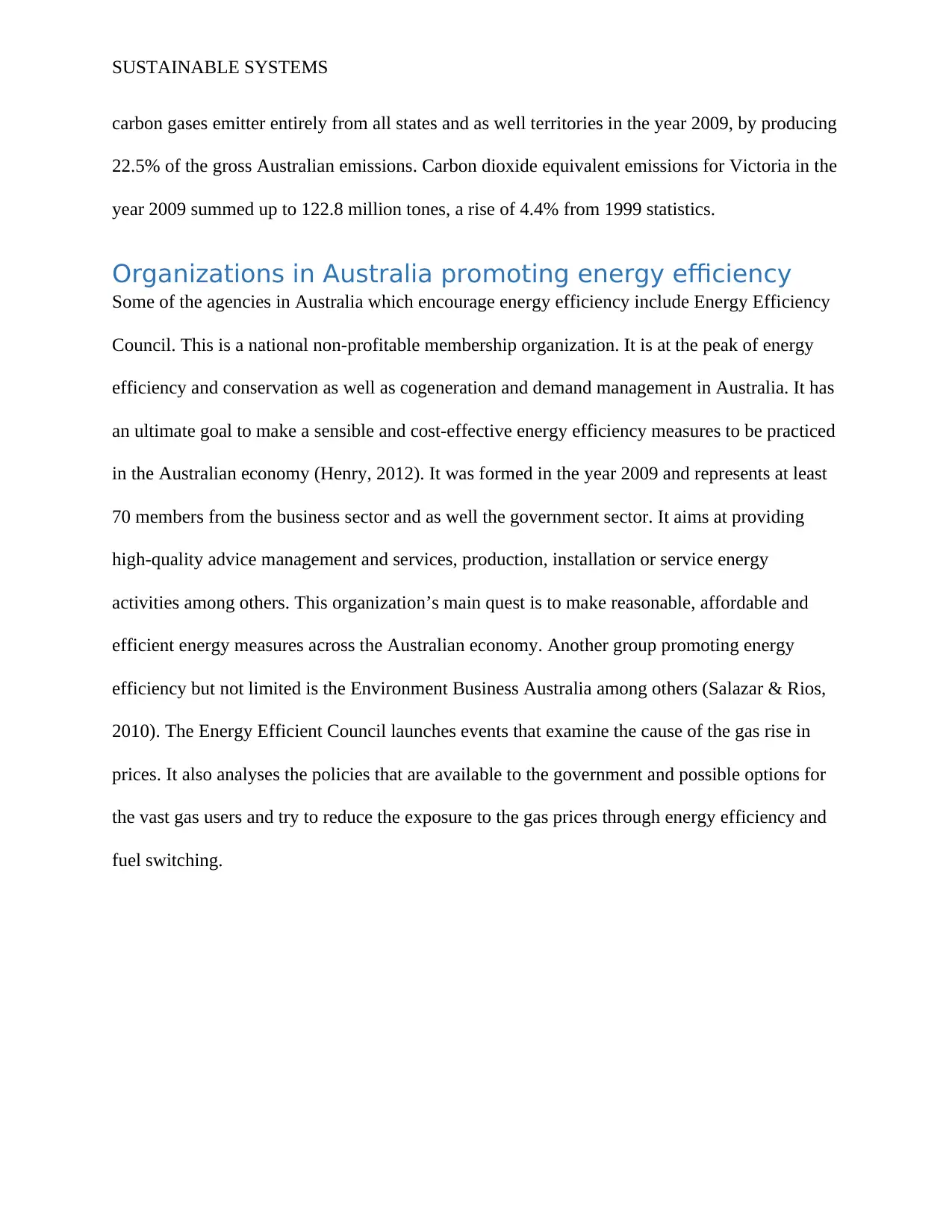
SUSTAINABLE SYSTEMS
carbon gases emitter entirely from all states and as well territories in the year 2009, by producing
22.5% of the gross Australian emissions. Carbon dioxide equivalent emissions for Victoria in the
year 2009 summed up to 122.8 million tones, a rise of 4.4% from 1999 statistics.
Organizations in Australia promoting energy efficiency
Some of the agencies in Australia which encourage energy efficiency include Energy Efficiency
Council. This is a national non-profitable membership organization. It is at the peak of energy
efficiency and conservation as well as cogeneration and demand management in Australia. It has
an ultimate goal to make a sensible and cost-effective energy efficiency measures to be practiced
in the Australian economy (Henry, 2012). It was formed in the year 2009 and represents at least
70 members from the business sector and as well the government sector. It aims at providing
high-quality advice management and services, production, installation or service energy
activities among others. This organization’s main quest is to make reasonable, affordable and
efficient energy measures across the Australian economy. Another group promoting energy
efficiency but not limited is the Environment Business Australia among others (Salazar & Rios,
2010). The Energy Efficient Council launches events that examine the cause of the gas rise in
prices. It also analyses the policies that are available to the government and possible options for
the vast gas users and try to reduce the exposure to the gas prices through energy efficiency and
fuel switching.
carbon gases emitter entirely from all states and as well territories in the year 2009, by producing
22.5% of the gross Australian emissions. Carbon dioxide equivalent emissions for Victoria in the
year 2009 summed up to 122.8 million tones, a rise of 4.4% from 1999 statistics.
Organizations in Australia promoting energy efficiency
Some of the agencies in Australia which encourage energy efficiency include Energy Efficiency
Council. This is a national non-profitable membership organization. It is at the peak of energy
efficiency and conservation as well as cogeneration and demand management in Australia. It has
an ultimate goal to make a sensible and cost-effective energy efficiency measures to be practiced
in the Australian economy (Henry, 2012). It was formed in the year 2009 and represents at least
70 members from the business sector and as well the government sector. It aims at providing
high-quality advice management and services, production, installation or service energy
activities among others. This organization’s main quest is to make reasonable, affordable and
efficient energy measures across the Australian economy. Another group promoting energy
efficiency but not limited is the Environment Business Australia among others (Salazar & Rios,
2010). The Energy Efficient Council launches events that examine the cause of the gas rise in
prices. It also analyses the policies that are available to the government and possible options for
the vast gas users and try to reduce the exposure to the gas prices through energy efficiency and
fuel switching.
⊘ This is a preview!⊘
Do you want full access?
Subscribe today to unlock all pages.

Trusted by 1+ million students worldwide
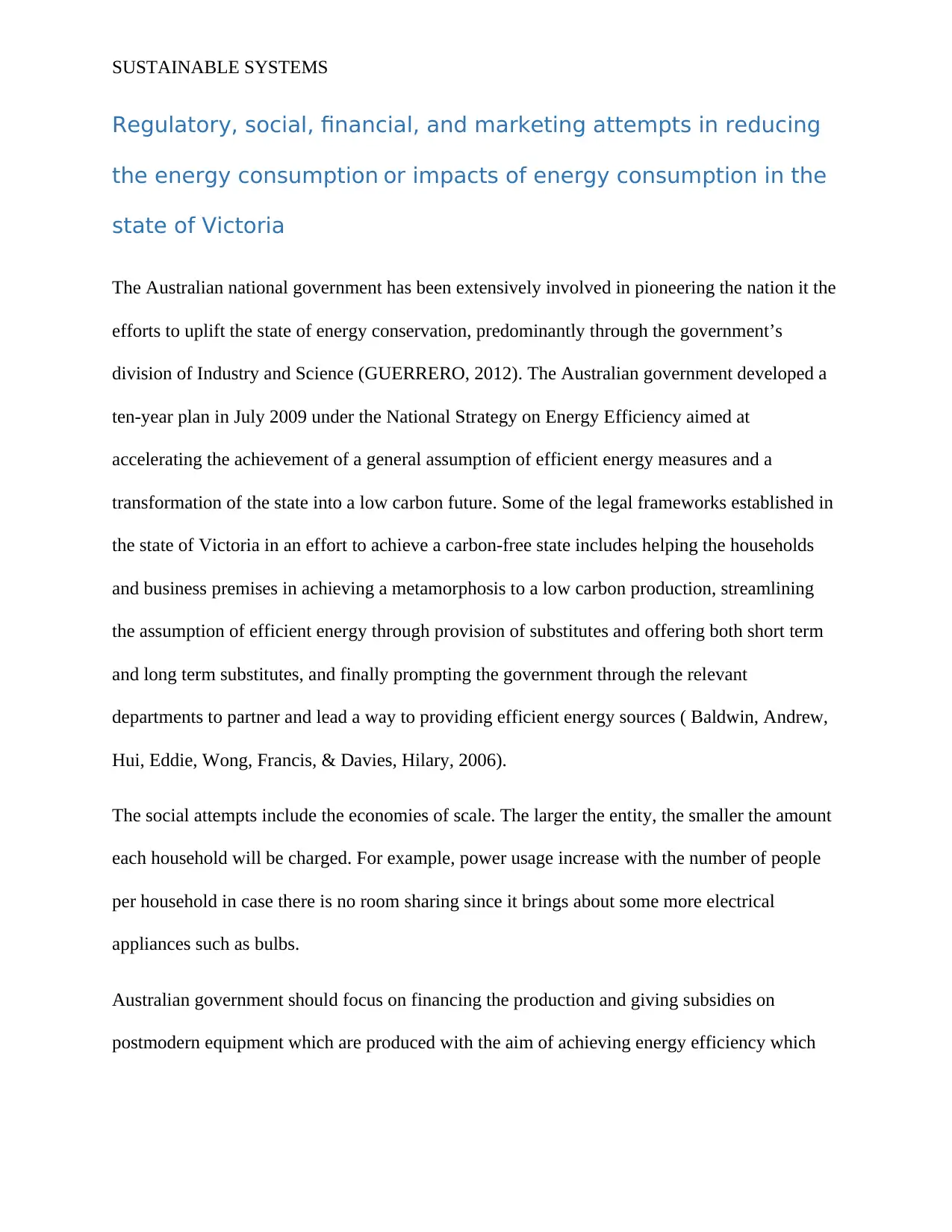
SUSTAINABLE SYSTEMS
Regulatory, social, financial, and marketing attempts in reducing
the energy consumption or impacts of energy consumption in the
state of Victoria
The Australian national government has been extensively involved in pioneering the nation it the
efforts to uplift the state of energy conservation, predominantly through the government’s
division of Industry and Science (GUERRERO, 2012). The Australian government developed a
ten-year plan in July 2009 under the National Strategy on Energy Efficiency aimed at
accelerating the achievement of a general assumption of efficient energy measures and a
transformation of the state into a low carbon future. Some of the legal frameworks established in
the state of Victoria in an effort to achieve a carbon-free state includes helping the households
and business premises in achieving a metamorphosis to a low carbon production, streamlining
the assumption of efficient energy through provision of substitutes and offering both short term
and long term substitutes, and finally prompting the government through the relevant
departments to partner and lead a way to providing efficient energy sources ( Baldwin, Andrew,
Hui, Eddie, Wong, Francis, & Davies, Hilary, 2006).
The social attempts include the economies of scale. The larger the entity, the smaller the amount
each household will be charged. For example, power usage increase with the number of people
per household in case there is no room sharing since it brings about some more electrical
appliances such as bulbs.
Australian government should focus on financing the production and giving subsidies on
postmodern equipment which are produced with the aim of achieving energy efficiency which
Regulatory, social, financial, and marketing attempts in reducing
the energy consumption or impacts of energy consumption in the
state of Victoria
The Australian national government has been extensively involved in pioneering the nation it the
efforts to uplift the state of energy conservation, predominantly through the government’s
division of Industry and Science (GUERRERO, 2012). The Australian government developed a
ten-year plan in July 2009 under the National Strategy on Energy Efficiency aimed at
accelerating the achievement of a general assumption of efficient energy measures and a
transformation of the state into a low carbon future. Some of the legal frameworks established in
the state of Victoria in an effort to achieve a carbon-free state includes helping the households
and business premises in achieving a metamorphosis to a low carbon production, streamlining
the assumption of efficient energy through provision of substitutes and offering both short term
and long term substitutes, and finally prompting the government through the relevant
departments to partner and lead a way to providing efficient energy sources ( Baldwin, Andrew,
Hui, Eddie, Wong, Francis, & Davies, Hilary, 2006).
The social attempts include the economies of scale. The larger the entity, the smaller the amount
each household will be charged. For example, power usage increase with the number of people
per household in case there is no room sharing since it brings about some more electrical
appliances such as bulbs.
Australian government should focus on financing the production and giving subsidies on
postmodern equipment which are produced with the aim of achieving energy efficiency which
Paraphrase This Document
Need a fresh take? Get an instant paraphrase of this document with our AI Paraphraser
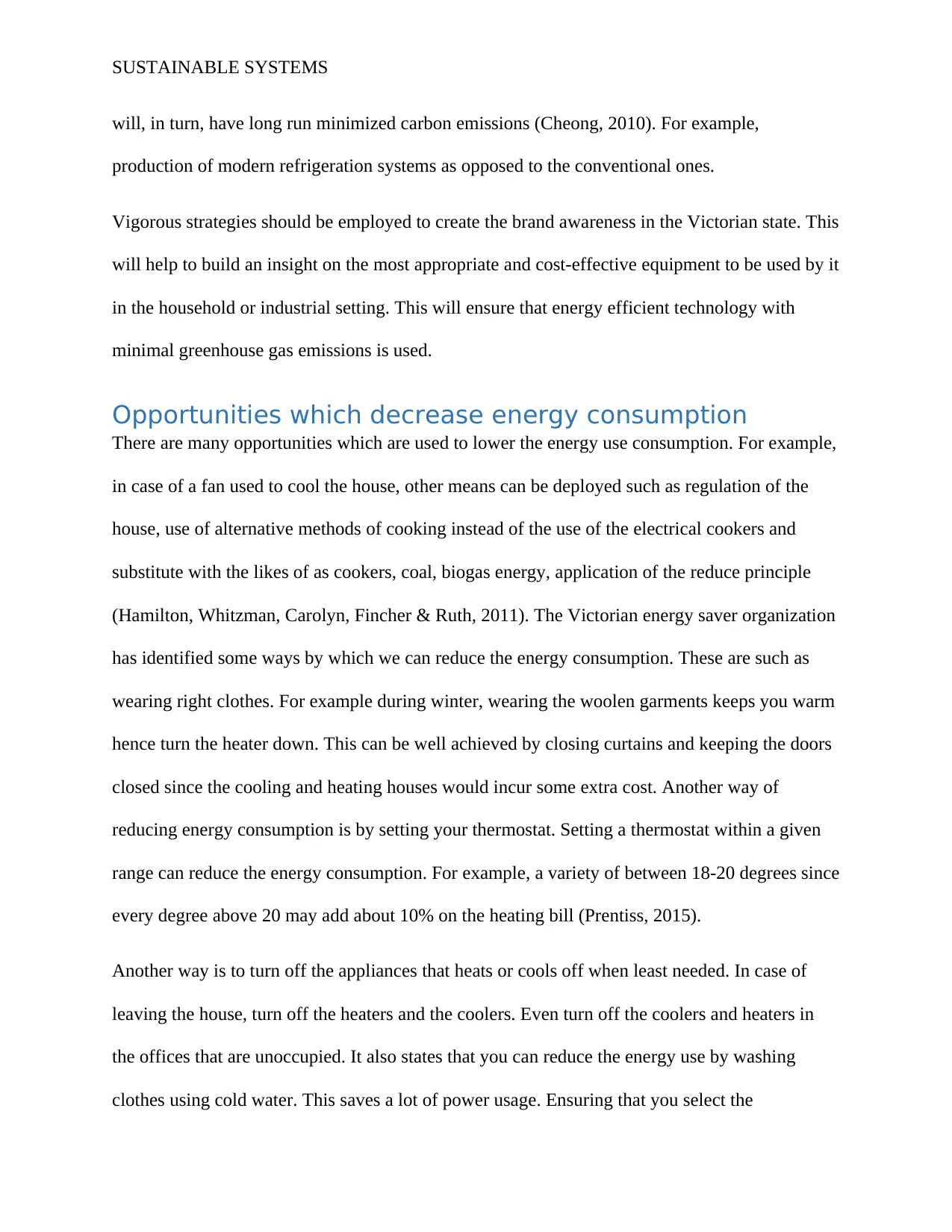
SUSTAINABLE SYSTEMS
will, in turn, have long run minimized carbon emissions (Cheong, 2010). For example,
production of modern refrigeration systems as opposed to the conventional ones.
Vigorous strategies should be employed to create the brand awareness in the Victorian state. This
will help to build an insight on the most appropriate and cost-effective equipment to be used by it
in the household or industrial setting. This will ensure that energy efficient technology with
minimal greenhouse gas emissions is used.
Opportunities which decrease energy consumption
There are many opportunities which are used to lower the energy use consumption. For example,
in case of a fan used to cool the house, other means can be deployed such as regulation of the
house, use of alternative methods of cooking instead of the use of the electrical cookers and
substitute with the likes of as cookers, coal, biogas energy, application of the reduce principle
(Hamilton, Whitzman, Carolyn, Fincher & Ruth, 2011). The Victorian energy saver organization
has identified some ways by which we can reduce the energy consumption. These are such as
wearing right clothes. For example during winter, wearing the woolen garments keeps you warm
hence turn the heater down. This can be well achieved by closing curtains and keeping the doors
closed since the cooling and heating houses would incur some extra cost. Another way of
reducing energy consumption is by setting your thermostat. Setting a thermostat within a given
range can reduce the energy consumption. For example, a variety of between 18-20 degrees since
every degree above 20 may add about 10% on the heating bill (Prentiss, 2015).
Another way is to turn off the appliances that heats or cools off when least needed. In case of
leaving the house, turn off the heaters and the coolers. Even turn off the coolers and heaters in
the offices that are unoccupied. It also states that you can reduce the energy use by washing
clothes using cold water. This saves a lot of power usage. Ensuring that you select the
will, in turn, have long run minimized carbon emissions (Cheong, 2010). For example,
production of modern refrigeration systems as opposed to the conventional ones.
Vigorous strategies should be employed to create the brand awareness in the Victorian state. This
will help to build an insight on the most appropriate and cost-effective equipment to be used by it
in the household or industrial setting. This will ensure that energy efficient technology with
minimal greenhouse gas emissions is used.
Opportunities which decrease energy consumption
There are many opportunities which are used to lower the energy use consumption. For example,
in case of a fan used to cool the house, other means can be deployed such as regulation of the
house, use of alternative methods of cooking instead of the use of the electrical cookers and
substitute with the likes of as cookers, coal, biogas energy, application of the reduce principle
(Hamilton, Whitzman, Carolyn, Fincher & Ruth, 2011). The Victorian energy saver organization
has identified some ways by which we can reduce the energy consumption. These are such as
wearing right clothes. For example during winter, wearing the woolen garments keeps you warm
hence turn the heater down. This can be well achieved by closing curtains and keeping the doors
closed since the cooling and heating houses would incur some extra cost. Another way of
reducing energy consumption is by setting your thermostat. Setting a thermostat within a given
range can reduce the energy consumption. For example, a variety of between 18-20 degrees since
every degree above 20 may add about 10% on the heating bill (Prentiss, 2015).
Another way is to turn off the appliances that heats or cools off when least needed. In case of
leaving the house, turn off the heaters and the coolers. Even turn off the coolers and heaters in
the offices that are unoccupied. It also states that you can reduce the energy use by washing
clothes using cold water. This saves a lot of power usage. Ensuring that you select the
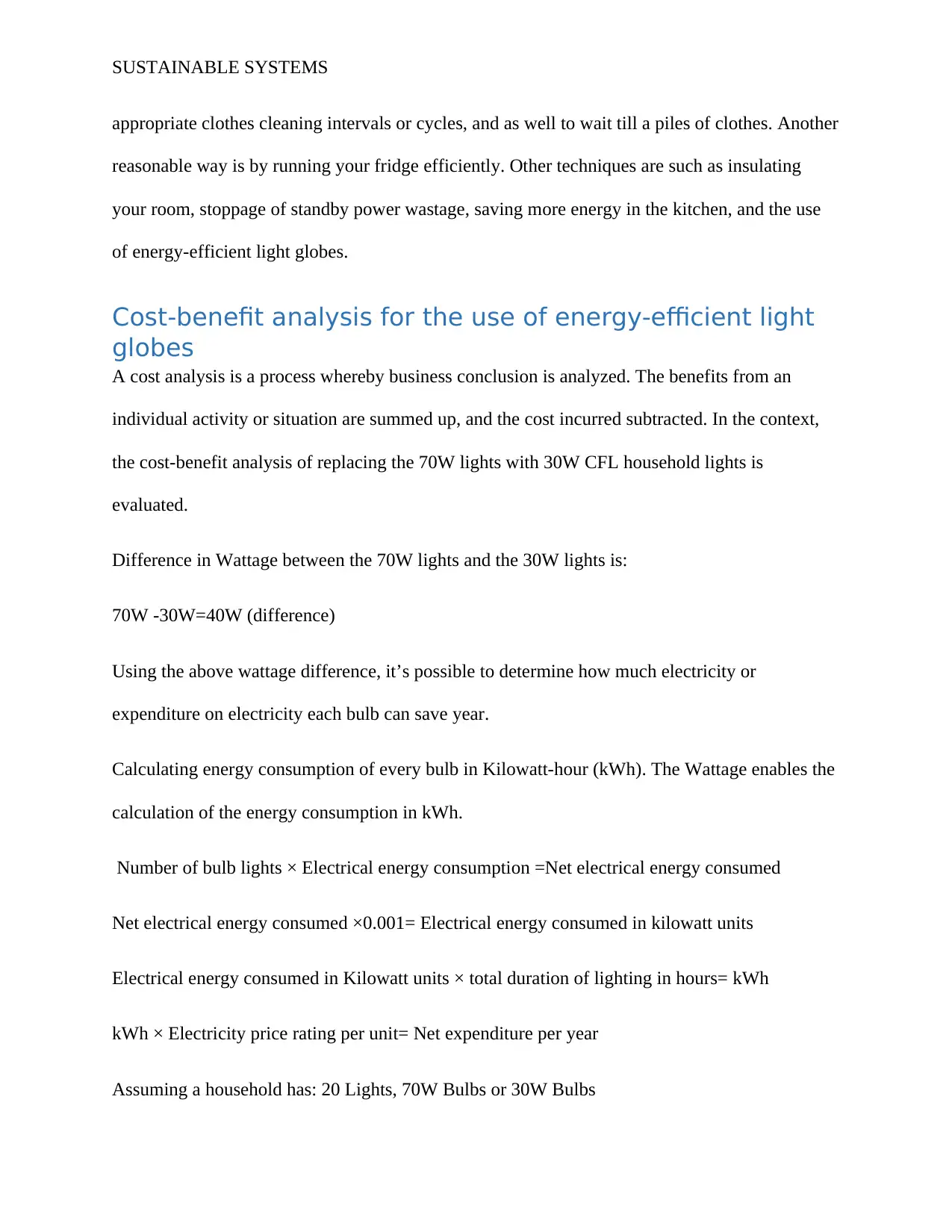
SUSTAINABLE SYSTEMS
appropriate clothes cleaning intervals or cycles, and as well to wait till a piles of clothes. Another
reasonable way is by running your fridge efficiently. Other techniques are such as insulating
your room, stoppage of standby power wastage, saving more energy in the kitchen, and the use
of energy-efficient light globes.
Cost-benefit analysis for the use of energy-efficient light
globes
A cost analysis is a process whereby business conclusion is analyzed. The benefits from an
individual activity or situation are summed up, and the cost incurred subtracted. In the context,
the cost-benefit analysis of replacing the 70W lights with 30W CFL household lights is
evaluated.
Difference in Wattage between the 70W lights and the 30W lights is:
70W -30W=40W (difference)
Using the above wattage difference, it’s possible to determine how much electricity or
expenditure on electricity each bulb can save year.
Calculating energy consumption of every bulb in Kilowatt-hour (kWh). The Wattage enables the
calculation of the energy consumption in kWh.
Number of bulb lights × Electrical energy consumption =Net electrical energy consumed
Net electrical energy consumed ×0.001= Electrical energy consumed in kilowatt units
Electrical energy consumed in Kilowatt units × total duration of lighting in hours= kWh
kWh × Electricity price rating per unit= Net expenditure per year
Assuming a household has: 20 Lights, 70W Bulbs or 30W Bulbs
appropriate clothes cleaning intervals or cycles, and as well to wait till a piles of clothes. Another
reasonable way is by running your fridge efficiently. Other techniques are such as insulating
your room, stoppage of standby power wastage, saving more energy in the kitchen, and the use
of energy-efficient light globes.
Cost-benefit analysis for the use of energy-efficient light
globes
A cost analysis is a process whereby business conclusion is analyzed. The benefits from an
individual activity or situation are summed up, and the cost incurred subtracted. In the context,
the cost-benefit analysis of replacing the 70W lights with 30W CFL household lights is
evaluated.
Difference in Wattage between the 70W lights and the 30W lights is:
70W -30W=40W (difference)
Using the above wattage difference, it’s possible to determine how much electricity or
expenditure on electricity each bulb can save year.
Calculating energy consumption of every bulb in Kilowatt-hour (kWh). The Wattage enables the
calculation of the energy consumption in kWh.
Number of bulb lights × Electrical energy consumption =Net electrical energy consumed
Net electrical energy consumed ×0.001= Electrical energy consumed in kilowatt units
Electrical energy consumed in Kilowatt units × total duration of lighting in hours= kWh
kWh × Electricity price rating per unit= Net expenditure per year
Assuming a household has: 20 Lights, 70W Bulbs or 30W Bulbs
⊘ This is a preview!⊘
Do you want full access?
Subscribe today to unlock all pages.

Trusted by 1+ million students worldwide
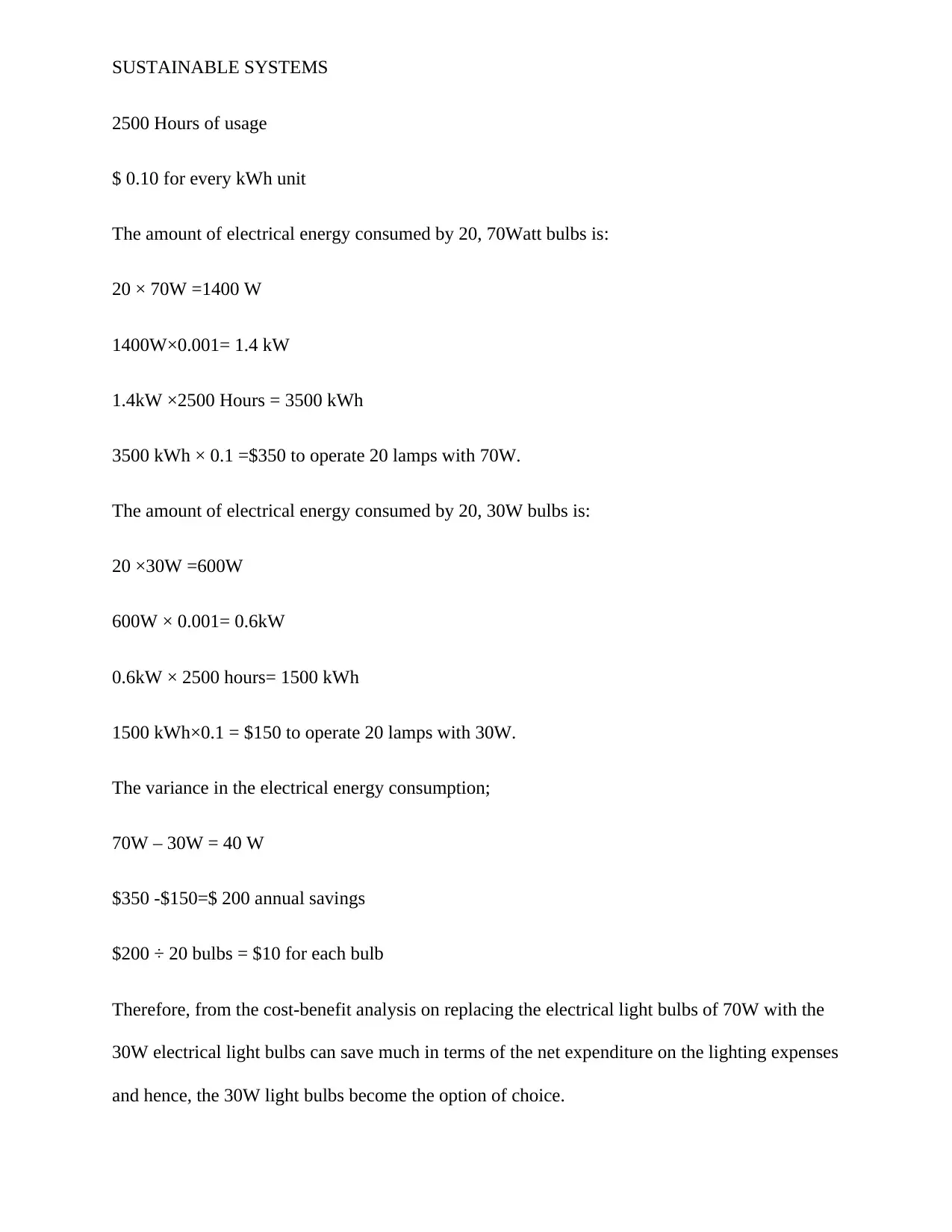
SUSTAINABLE SYSTEMS
2500 Hours of usage
$ 0.10 for every kWh unit
The amount of electrical energy consumed by 20, 70Watt bulbs is:
20 × 70W =1400 W
1400W×0.001= 1.4 kW
1.4kW ×2500 Hours = 3500 kWh
3500 kWh × 0.1 =$350 to operate 20 lamps with 70W.
The amount of electrical energy consumed by 20, 30W bulbs is:
20 ×30W =600W
600W × 0.001= 0.6kW
0.6kW × 2500 hours= 1500 kWh
1500 kWh×0.1 = $150 to operate 20 lamps with 30W.
The variance in the electrical energy consumption;
70W – 30W = 40 W
$350 -$150=$ 200 annual savings
$200 ÷ 20 bulbs = $10 for each bulb
Therefore, from the cost-benefit analysis on replacing the electrical light bulbs of 70W with the
30W electrical light bulbs can save much in terms of the net expenditure on the lighting expenses
and hence, the 30W light bulbs become the option of choice.
2500 Hours of usage
$ 0.10 for every kWh unit
The amount of electrical energy consumed by 20, 70Watt bulbs is:
20 × 70W =1400 W
1400W×0.001= 1.4 kW
1.4kW ×2500 Hours = 3500 kWh
3500 kWh × 0.1 =$350 to operate 20 lamps with 70W.
The amount of electrical energy consumed by 20, 30W bulbs is:
20 ×30W =600W
600W × 0.001= 0.6kW
0.6kW × 2500 hours= 1500 kWh
1500 kWh×0.1 = $150 to operate 20 lamps with 30W.
The variance in the electrical energy consumption;
70W – 30W = 40 W
$350 -$150=$ 200 annual savings
$200 ÷ 20 bulbs = $10 for each bulb
Therefore, from the cost-benefit analysis on replacing the electrical light bulbs of 70W with the
30W electrical light bulbs can save much in terms of the net expenditure on the lighting expenses
and hence, the 30W light bulbs become the option of choice.
Paraphrase This Document
Need a fresh take? Get an instant paraphrase of this document with our AI Paraphraser
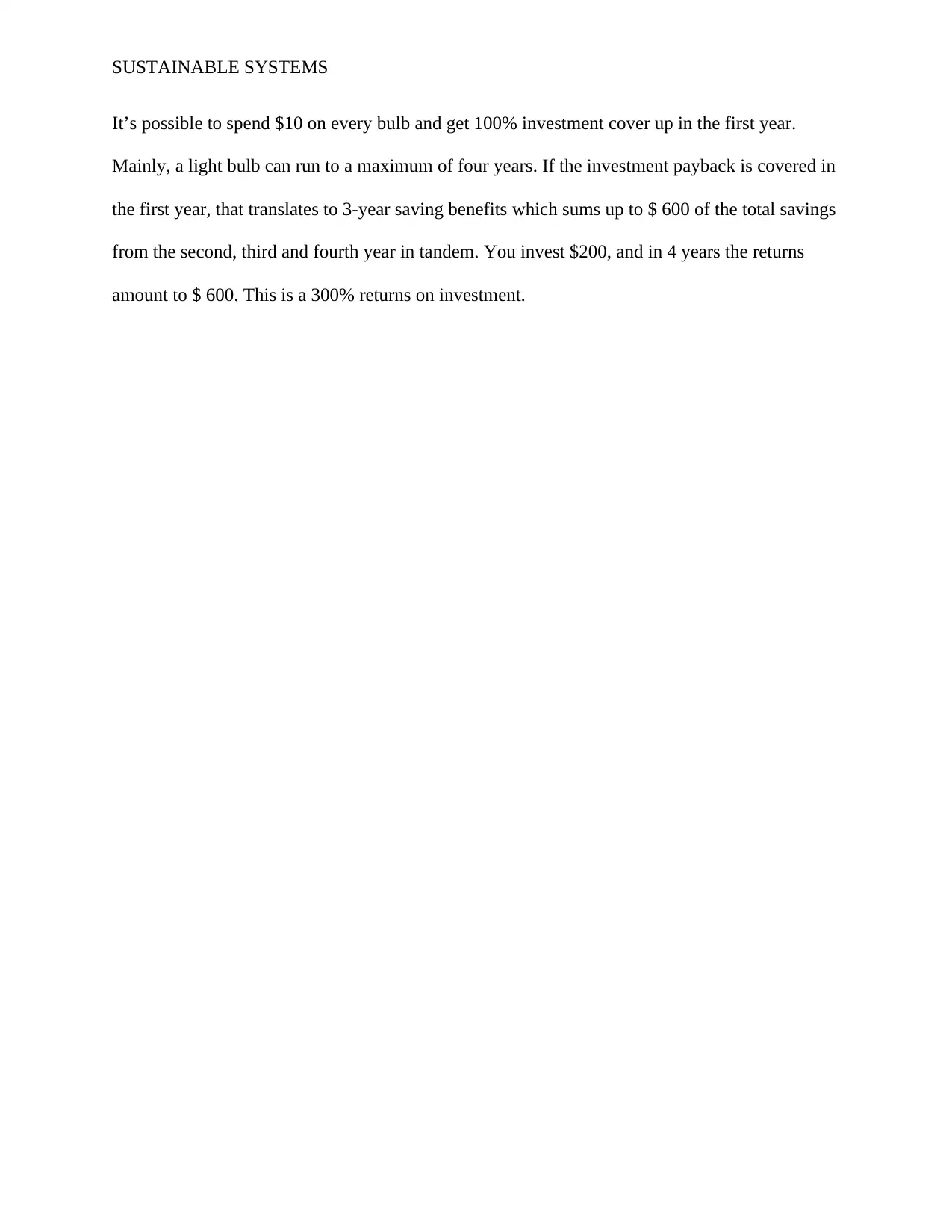
SUSTAINABLE SYSTEMS
It’s possible to spend $10 on every bulb and get 100% investment cover up in the first year.
Mainly, a light bulb can run to a maximum of four years. If the investment payback is covered in
the first year, that translates to 3-year saving benefits which sums up to $ 600 of the total savings
from the second, third and fourth year in tandem. You invest $200, and in 4 years the returns
amount to $ 600. This is a 300% returns on investment.
It’s possible to spend $10 on every bulb and get 100% investment cover up in the first year.
Mainly, a light bulb can run to a maximum of four years. If the investment payback is covered in
the first year, that translates to 3-year saving benefits which sums up to $ 600 of the total savings
from the second, third and fourth year in tandem. You invest $200, and in 4 years the returns
amount to $ 600. This is a 300% returns on investment.
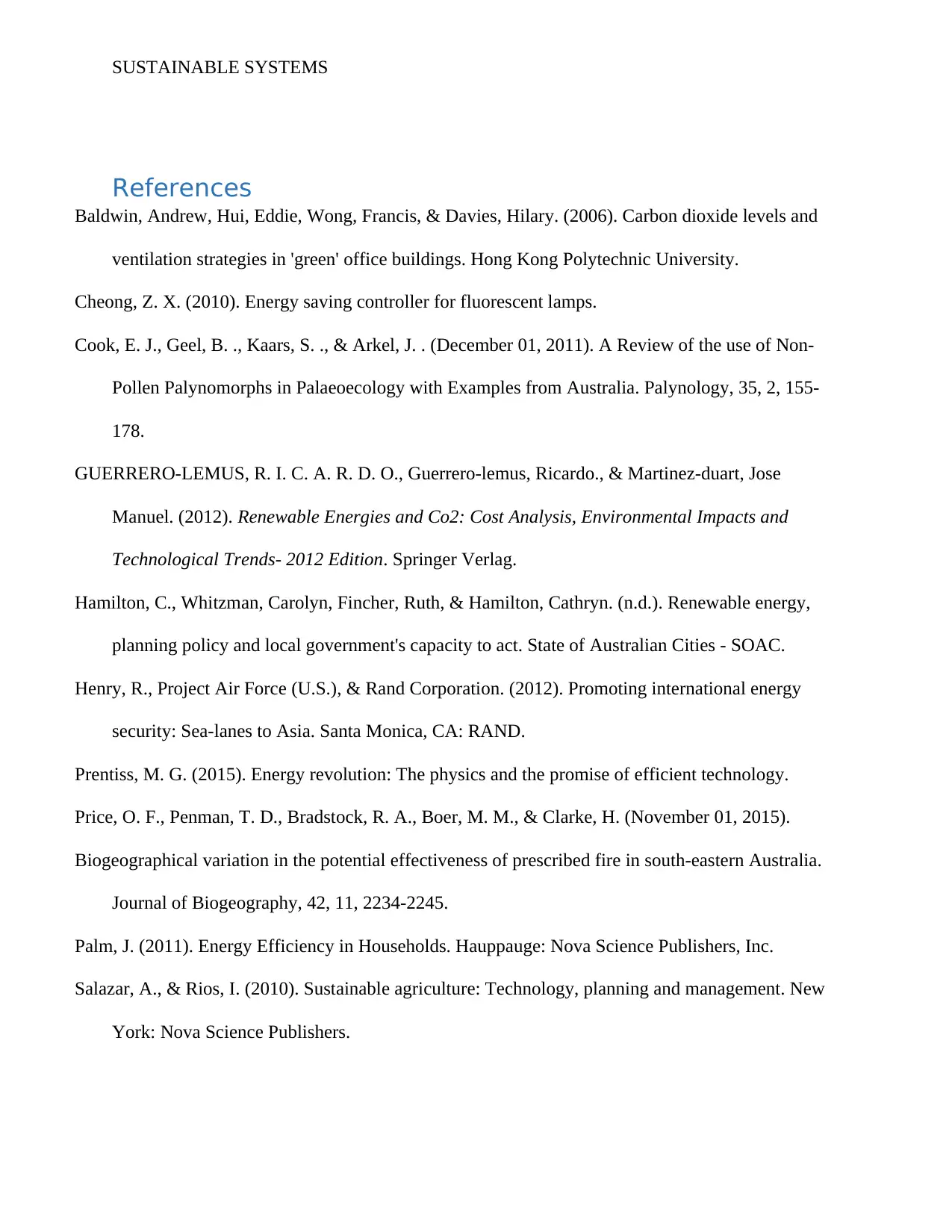
SUSTAINABLE SYSTEMS
References
Baldwin, Andrew, Hui, Eddie, Wong, Francis, & Davies, Hilary. (2006). Carbon dioxide levels and
ventilation strategies in 'green' office buildings. Hong Kong Polytechnic University.
Cheong, Z. X. (2010). Energy saving controller for fluorescent lamps.
Cook, E. J., Geel, B. ., Kaars, S. ., & Arkel, J. . (December 01, 2011). A Review of the use of Non-
Pollen Palynomorphs in Palaeoecology with Examples from Australia. Palynology, 35, 2, 155-
178.
GUERRERO-LEMUS, R. I. C. A. R. D. O., Guerrero-lemus, Ricardo., & Martinez-duart, Jose
Manuel. (2012). Renewable Energies and Co2: Cost Analysis, Environmental Impacts and
Technological Trends- 2012 Edition. Springer Verlag.
Hamilton, C., Whitzman, Carolyn, Fincher, Ruth, & Hamilton, Cathryn. (n.d.). Renewable energy,
planning policy and local government's capacity to act. State of Australian Cities - SOAC.
Henry, R., Project Air Force (U.S.), & Rand Corporation. (2012). Promoting international energy
security: Sea-lanes to Asia. Santa Monica, CA: RAND.
Prentiss, M. G. (2015). Energy revolution: The physics and the promise of efficient technology.
Price, O. F., Penman, T. D., Bradstock, R. A., Boer, M. M., & Clarke, H. (November 01, 2015).
Biogeographical variation in the potential effectiveness of prescribed fire in south-eastern Australia.
Journal of Biogeography, 42, 11, 2234-2245.
Palm, J. (2011). Energy Efficiency in Households. Hauppauge: Nova Science Publishers, Inc.
Salazar, A., & Rios, I. (2010). Sustainable agriculture: Technology, planning and management. New
York: Nova Science Publishers.
References
Baldwin, Andrew, Hui, Eddie, Wong, Francis, & Davies, Hilary. (2006). Carbon dioxide levels and
ventilation strategies in 'green' office buildings. Hong Kong Polytechnic University.
Cheong, Z. X. (2010). Energy saving controller for fluorescent lamps.
Cook, E. J., Geel, B. ., Kaars, S. ., & Arkel, J. . (December 01, 2011). A Review of the use of Non-
Pollen Palynomorphs in Palaeoecology with Examples from Australia. Palynology, 35, 2, 155-
178.
GUERRERO-LEMUS, R. I. C. A. R. D. O., Guerrero-lemus, Ricardo., & Martinez-duart, Jose
Manuel. (2012). Renewable Energies and Co2: Cost Analysis, Environmental Impacts and
Technological Trends- 2012 Edition. Springer Verlag.
Hamilton, C., Whitzman, Carolyn, Fincher, Ruth, & Hamilton, Cathryn. (n.d.). Renewable energy,
planning policy and local government's capacity to act. State of Australian Cities - SOAC.
Henry, R., Project Air Force (U.S.), & Rand Corporation. (2012). Promoting international energy
security: Sea-lanes to Asia. Santa Monica, CA: RAND.
Prentiss, M. G. (2015). Energy revolution: The physics and the promise of efficient technology.
Price, O. F., Penman, T. D., Bradstock, R. A., Boer, M. M., & Clarke, H. (November 01, 2015).
Biogeographical variation in the potential effectiveness of prescribed fire in south-eastern Australia.
Journal of Biogeography, 42, 11, 2234-2245.
Palm, J. (2011). Energy Efficiency in Households. Hauppauge: Nova Science Publishers, Inc.
Salazar, A., & Rios, I. (2010). Sustainable agriculture: Technology, planning and management. New
York: Nova Science Publishers.
⊘ This is a preview!⊘
Do you want full access?
Subscribe today to unlock all pages.

Trusted by 1+ million students worldwide
1 out of 13
Related Documents
Your All-in-One AI-Powered Toolkit for Academic Success.
+13062052269
info@desklib.com
Available 24*7 on WhatsApp / Email
![[object Object]](/_next/static/media/star-bottom.7253800d.svg)
Unlock your academic potential
Copyright © 2020–2025 A2Z Services. All Rights Reserved. Developed and managed by ZUCOL.





